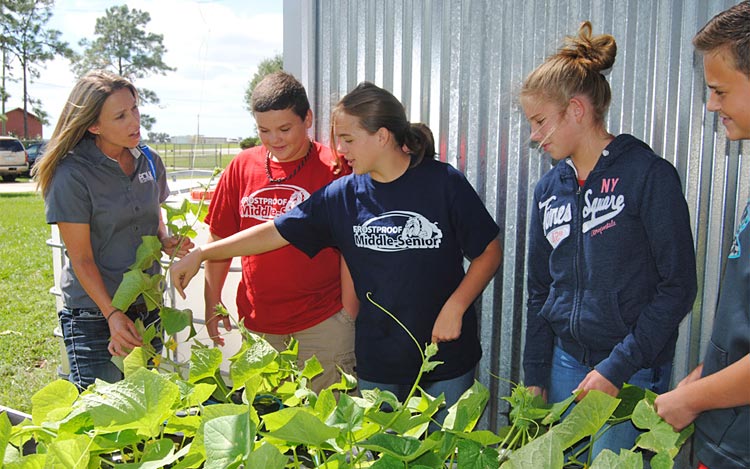Frostproof Middle-Senior High School Ag Department Earns Polk County Farm Bureau honor
THE FROSTPROOF MIDDLE-SENIOR HIGH SCHOOL Agriculture Department has been honored by the Polk County Farm Bureau as its 2016 Outstanding Ag Program of the Year. The school ag program received the award Oct. 11 during the PCFB annual meeting in Bartow.
The Frostproof school, which has been educating students in agriculture for 63 years, was lauded by the PCFB, in large part, because the Agriscience AgDogs Academy, which the department is called, recently earned Model Accreditation from the National Career Academy Committee (NCAC). Model Accreditation is the highest accreditation that can be received, says Clay Brantley, an academy instructor and Future Farmers of America adviser.
The Frostproof agriculture students are provided with the unique opportunities to experience collaborative learning, Brantley says. “For example, our ag students participate in cohort lessons studying soil and water pH levels with our science department, students are learning how to figure linear footage and calculate fertilizer ratios with our math department, and this year we will do food prep with our culinary program,” Brantley says. “Additionally, our English teachers offer feedback to our FFA leadership programs.”
The agriculture department offers a diversified curriculum. Topics include FFA and leadership, ag safety issues, aquaculture, animal science, plant science, and fundamentals of agricultural mechanics.
“Our land labs reflect the diversification of our program, as we raise fish, laying chickens, blueberries, seasonal gardens, and a large number of beef cattle,” Brantley says.
The students receive detailed class work as time allows, Brantley adds. He notes that the FFA leadership program provides the officer teams with team-building opportunities and leadership training throughout the school year and into the summer. “Leadership skills are integrated into our program as we discuss what it takes to be a leader, how to be accountable for our actions, and how these opportunities are going to help out students with everyday life,” Brantley says.
The ag students work hands-on with livestock, fish, chickens, shop projects, and gardening to learn responsible stewardship and how to produce quality projects. Many local industry partners visit the school or the students go to them on educational field trips. The school’s partners provide students with exposure to diverse ag industries, including citrus, forestry, exotic animals, blueberries, seed cooperatives, and veterinary services at the cattle land lab. This school year, the ag department staff plans to introduce students to drones and how they might offer future ag-related job opportunities. Brantley says that by the time the students complete the ag academy, they are exposed fully to the ways of the industry— from production through marketing.
Agriculture instructor Catherine Ogburn and Brantley work with both the high school and middle school ag programs, which share the same learning facilities. This is an advantage, the instructors say, sharing that because the high school students have gone through the middle school pre-academy, they know the expectations of the school’s higher-level ag and FFA programs.
Recently, the ag department received a $3,500 Duke Energy grant that will be used to expand the school’s aquaponics system to two open fish tanks and three raceway grow beds. The system will help the students produce fish, lettuce, and kale throughout the year. Working in a hands-on way, students will learn about water quality, the nitrogen cycle, growing with hydroponics, and aquaculture.
“In addition, the aquaponics system is a great educational tool to integrate science and math standards into our agriscience program,” Brantley says. “The opportunities for our students are endless.”
CREDITS
story by BRENDA EGGERT BRADER
photos by ABBY CRAWFORD

